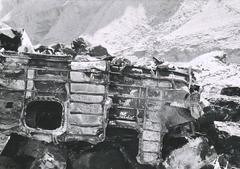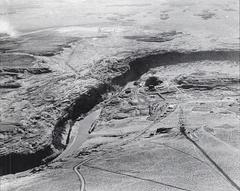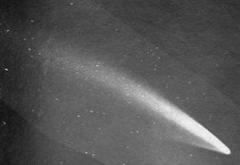
Tusayan Ruins Visiting Hours, Tickets, and Marble Canyon Historical Sites Guide
Date: 04/07/2025
Introduction
Northern Arizona stands as a tapestry of history, culture, and natural splendor. Among its most captivating destinations are the Tusayan Ruins—offering a window into the daily lives of Ancestral Puebloans—and Marble Canyon, where the Colorado River carves breathtaking geological formations. This guide provides comprehensive details on Tusayan Ruins visiting hours, ticket information, accessibility, and a curated look at Marble Canyon’s top attractions and historical significance. Whether you are a history enthusiast, outdoor adventurer, or cultural explorer, understanding these sites will enrich your journey through Arizona’s canyon country (Wikipedia; Inspired Imperfection; World Atlas; Visit Marble Canyon).
Table of Contents
- Introduction
- Historical and Cultural Significance
- Visitor Experience and Attractions
- Accessibility and Practical Considerations
- Combined Itinerary: Experiencing Both Sites
- Nearby Attractions
- Frequently Asked Questions (FAQ)
- Visuals and Media Suggestions
- Internal and External Links
- Conclusion
Discover the Tusayan Ruins and Museum: A Complete Visitor’s Guide
Historical Background
The Tusayan Ruins, or Tusayan Pueblo, are among the best-preserved archaeological sites along the Grand Canyon’s South Rim, dating to around 1185 CE. Established through dendrochronology (tree ring analysis), the site was inhabited by Ancestral Puebloans for roughly two decades. Its excavation began in 1930, and preservation efforts have since ensured its role as an educational resource and cultural touchstone. In 1974, the ruins were added to the National Register of Historic Places (Wikipedia; Atlas Obscura).
Archaeological Features
The site consists of a compact, U-shaped pueblo with a central plaza, living quarters, storage rooms, and at least one kiva—a subterranean ceremonial chamber. The ruins are interpreted through detailed signage and are estimated to have housed 15–20 people (Atlas Obscura; Inspired Imperfection).
The Tusayan Museum
Adjacent to the ruins, the Tusayan Museum—built in 1932 by Herbert Maier and expanded in 1934—reflects Hopi architectural traditions. Inside, visitors discover pottery, tools, and jewelry dating back up to 4,000 years, highlighting ancestral craftsmanship and cultural continuity (Wikipedia; The Tourist Checklist).
Visitor Information
Location and Access
The Tusayan Ruins and Museum are located along Desert View Drive (Arizona State Route 64), three miles west of Desert View Watchtower and 20 miles east of Grand Canyon Village. Ample parking is provided, and the site is accessible to most visitors (Camera and a Canvas).
Visiting Hours
Generally open daily from 9:00 am to 5:00 pm, though seasonal changes may occur. Stay updated via the National Park Service website.
Tickets and Fees
Admission to the Tusayan Ruins and Museum is included with your Grand Canyon National Park entrance pass; no separate ticket is required.
Trails and Accessibility
A 0.1-mile, mostly flat gravel trail loops around the ruins, suitable for most mobility levels. Interpretive signs line the route, and restrooms and picnic areas are nearby (Inspired Imperfection).
Interpretation and Guided Experiences
Ranger-led tours and special events, including Native American storytelling and craft demonstrations, are offered throughout the year. Self-guided exploration is supported by extensive signage and museum exhibits (Wikipedia; The Tourist Checklist).
Cultural Significance
The Tusayan Ruins connect directly to the heritage of the Hopi, Zuni, and other Puebloan peoples, highlighting advanced architecture and ceremonial life. The National Park Service collaborates with tribal communities to ensure the site’s respectful stewardship (Inspired Imperfection).
Visitor Tips
- Best Time to Visit: Spring and fall for pleasant weather.
- Essentials: Comfortable shoes, water, sun protection, and a camera.
- Photography: Morning or late afternoon for optimal lighting.
- Nearby Attractions: Desert View Watchtower offers panoramic vistas and additional exhibits (Desert View Watchtower).
- Accessibility: Check the NPS website for updates.
- Leave No Trace: Remain on marked paths and avoid disturbing artifacts.
Marble Canyon: Gateway to Adventure and Geology
Overview
Marble Canyon marks the official beginning of the Grand Canyon, stretching over 60 miles from Lee’s Ferry to the confluence with the Little Colorado River. Its polished limestone walls recall the look of marble, a detail observed by explorer John Wesley Powell (World Atlas). The canyon straddles cultural boundaries, with the Navajo Nation to the east and the Kaibab Plateau to the west, and is a site of both natural and cultural significance (GRC History).
Visiting Hours and Tickets
- Hours: Open daily from sunrise to sunset; Lee’s Ferry Visitor Center operates from 8:00 am to 5:00 pm.
- Tickets/Permits: No general entrance fee. Permits are required for rafting and some hikes (World Atlas).
- Accessibility: The Navajo Bridge and visitor center are accessible; trail difficulty varies.
Key Attractions and Activities
- Navajo Bridge: Historic 1929 bridge, now a pedestrian walkway with dramatic river views and birdwatching opportunities (Visit Marble Canyon).
- Lee’s Ferry: Launch site for river excursions and a renowned fishing location (The Travel).
- Hiking: Trails like Cathedral Wash reveal layers of canyon geology; nearby slot canyons such as Antelope Canyon are accessible via guided tours (Visit Marble Canyon).
- Rafting/Kayaking: Launches from Lee’s Ferry require advance permits.
- Wildlife Watching: The area is prime for spotting California condors, eagles, and desert wildlife (World Atlas).
- Historical Sites: Lonely Dell Ranch and Marble Canyon Lodge provide insight into pioneer and trading post history (The Travel).
Practical Information
- Getting There: Reach Marble Canyon via US-89A; Page, AZ is 30 miles away, and Flagstaff is two hours south (Parks and Trips).
- Weather: Spring and fall are ideal; summers are hot, winters are chilly (Visit Marble Canyon).
- Accommodations: Marble Canyon Lodge, Cliff Dwellers Lodge, and Lees Ferry Lodge are local options; more choices in Page and Flagstaff (The Travel).
- Packing: Bring water, snacks, sunscreen, layered clothing, and sturdy footwear (The Tourist Checklist).
- Services: Limited; plan ahead (Visit Marble Canyon).
- Wildlife and Safety: Observe animals at a distance and monitor weather conditions (The Tourist Checklist).
Combined Itinerary: Tusayan Ruins and Marble Canyon
Day 1:
- Enter Grand Canyon National Park via East Entrance.
- Visit Desert View Watchtower, then explore Tusayan Ruins and Museum.
- Overnight in Grand Canyon Village or Tusayan.
Day 2:
- Drive to Marble Canyon via AZ-64 and US-89.
- Walk Navajo Bridge, visit the interpretive center, and explore local trails.
- Overnight at a lodge or campground.
Day 3:
- Visit Lee’s Ferry and Vermilion Cliffs National Monument.
- Depart to your next Arizona destination.
Nearby Attractions
- Vermilion Cliffs National Monument (Visit Marble Canyon)
- Horseshoe Bend (Visit Marble Canyon)
- Grand Canyon East and North Rims (Visit Marble Canyon)
Frequently Asked Questions (FAQ)
Tusayan Ruins
- What are the visiting hours? 9:00 am – 5:00 pm daily.
- Do I need a ticket? Admission is included with your Grand Canyon National Park pass.
- Are guided tours available? Yes, ranger-led programs are offered seasonally.
- Is the site accessible? The trail is short and mostly flat; check NPS updates.
Marble Canyon
- What are the visiting hours? Sunrise to sunset, year-round; visitor center 8:00 am – 5:00 pm.
- Are tickets required? No general entrance fee; permits required for river trips and some hikes.
- Is it suitable for beginners? There are trails for all skill levels.
- Is it accessible? Key sites like Navajo Bridge are wheelchair accessible.
Visuals and Media Suggestions
- Use high-quality images of Tusayan Ruins, museum interiors, Marble Canyon cliffs, and Navajo Bridge (with descriptive alt tags like “Tusayan Ruins visiting hours Grand Canyon” and “Marble Canyon hiking Arizona”).
- Embed an interactive map showing both sites and key trails.
- Feature virtual tours of the Tusayan Museum and Marble Canyon where available.
Internal and External Links
- Internal links: Related articles such as “Top Hiking Trails at the Grand Canyon” and “Camping Tips for Arizona National Parks.”
- External links: Maintain current credible sources for visitor resources.
Conclusion
Combining the archaeological intrigue of the Tusayan Ruins with the scenic and adventurous offerings of Marble Canyon gives travelers a holistic glimpse of Arizona’s rich heritage and natural wonders. With accessible facilities, free or minimal entry fees, and diverse activities, both sites cater to history buffs, families, and outdoor enthusiasts. For the best experience, visit in spring or fall, respect local cultures, and use up-to-date resources such as the National Park Service website and the Audiala app for planning.
References
- Tusayan Ruins - Wikipedia
- Tusayan Ruins - Atlas Obscura
- Tusayan Ruins and Museum - Inspired Imperfection
- Marble Canyon - World Atlas
- Visit Marble Canyon
- Tusayan Ruins and Museum - Grand Canyon Deals
- Marble Canyon - My Camping Vacation Sites
- Grand Canyon National Park Visitor Centers - NPS






